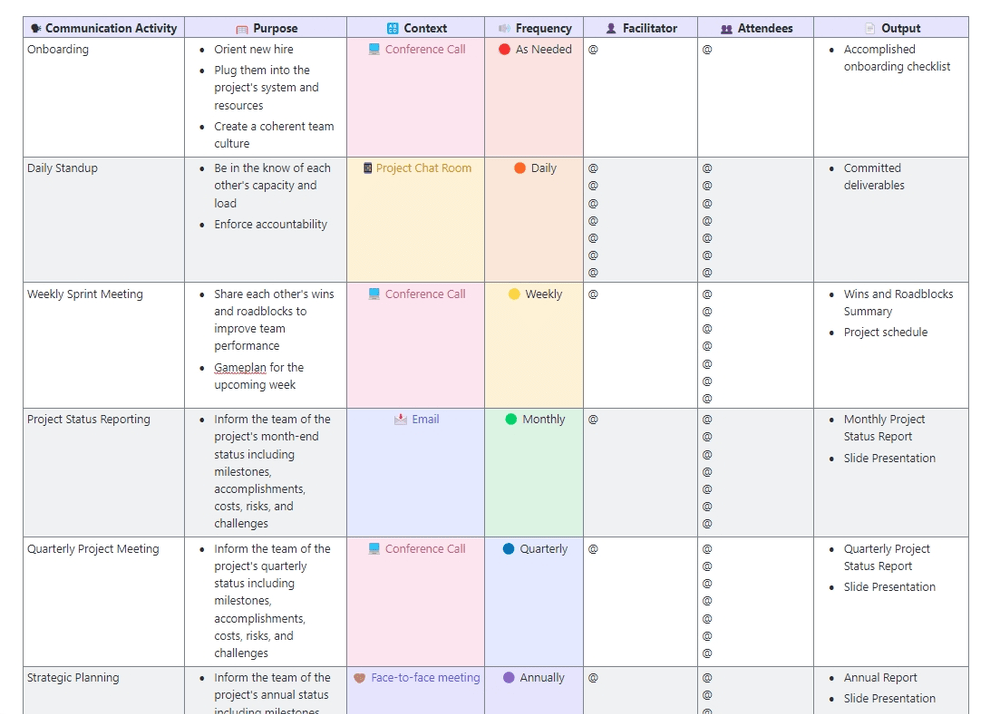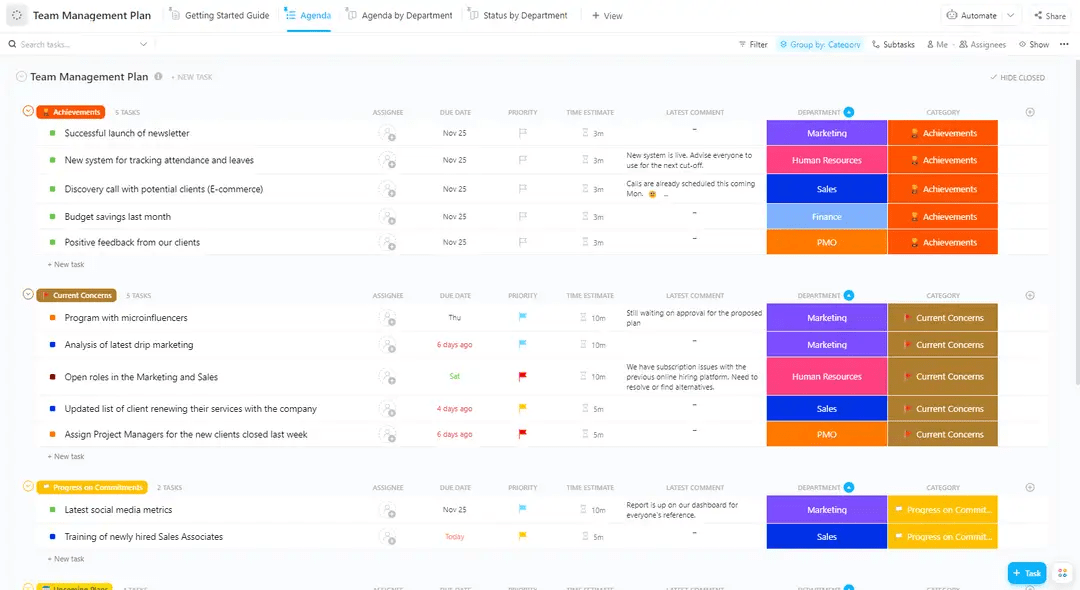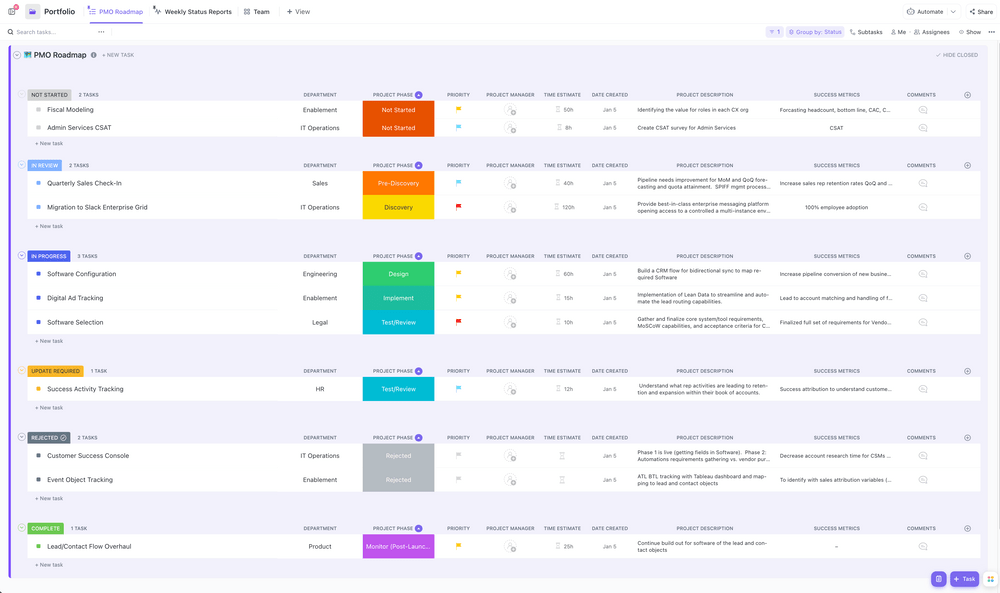الموظفون السعداء مفيدون للعمل. ولكن من الصعب إبقاء الجميع متحمسين في جميع الأوقات.
وفقًا لـ تقرير غالوب أن 59% من الموظفين على مستوى العالم "مستقيلون هادئون"، في حين أن 18% من الموظفين غير منخرطين في العمل أو "مستقيلون بصوت عالٍ"
تخسر أماكن العمل في جميع أنحاء العالم الإنتاجية بسبب هذا الأمر - حيث تبلغ خسارة الإنتاجية بسبب انخفاض مستويات المشاركة في العمل 8.8 تريليون دولار سنويًا!
فما أسباب هذه الكآبة والكآبة؟ هناك العديد من العوامل المؤثرة هنا، مثل التغيرات التي طرأت على ثقافة العمل بعد الجائحة، ونقص التواصل، والتسريح الجماعي للموظفين، وزيادة مستويات التوتر.
أدخل محترفي الموارد البشرية! إنهم أفضل من يجعلك أنت وفريقك تشعرون بالدعم والمشاركة في العمل. فهم يهدفون إلى خلق ثقافة عمل عالية الأداء وتطبيق سياسات صديقة للموظفين تساعد على تعزيز الإنتاجية.
أنت تعلم أنك تعمل في شركة ذات معنويات عالية عندما
- يسعدك أن تكون جزءًا من فريق العمل
- تجد معنى ورضا في عملك
- السعي نحو النجاح الفردي والمؤسسي
- إدارة توازن صحي بين العمل والحياة الشخصية
- الشعور بأنك مرئي ومسموع من قبل الإدارة العليا
تعتبر هذه المقالة نقطة انطلاق جيدة للحصول على هذا المنظور الذي تشتد الحاجة إليه. دعونا نلقي نظرة على طرق تعزيز معنويات الموظفين باستخدام التكنولوجيا وتنفيذ استراتيجيات القيادة القابلة للتنفيذ.
ما هي معنويات الفريق؟
الروح المعنوية للفريق هي التفاؤل والحماس والثقة الجماعية لمجموعة من الأشخاص الذين يعملون معًا في مؤسسة ما. وهي تعكس الموقف العام لأعضاء الفريق تجاه زملائهم في العمل وعملهم ومنظمتهم.
معنويات الموظفين مهمة لأنها المفتاح لمكان عمل أكثر سعادة، حيث يبقى الزملاء لفترة أطول بدلاً من القفز من السفينة عند حدوث أي إزعاج بسيط. إليك السبب الذي يجعل مكان العمل الشامل يحدث فرقًا كبيرًا:
- الرضا الوظيفي: الموظفون الذين يتمتعون بروح معنوية عالية يكونون راضين ومتحمسين ويجدون الرضا في عملهم
- الاحتفاظ بالمواهب: الموظفون الراضون يشعرون بالانتماء ويقدمون أفضل ما لديهم
- الثقافة المؤسسية: ثقافة العمل الإيجابية والشاملة، حيث يشعر القادة الموظفين بالتقدير ويعززون معنويات الفريق
يمكن أن يؤدي تعزيز معنويات الموظفين إلى تحقيق المعجزات لثقافة شركتك بالإضافة إلى تحسين إنتاجية الموظفين والإبداع والتعاون. وعلى العكس من ذلك، فإن انخفاض الروح المعنوية يمكن أن يضر برضا الموظفين ويؤدي إلى ضعف الأداء.
أسباب انخفاض الروح المعنوية للموظفين
انخفاض الروح المعنوية في الشركة هو عامل مخادع يمكن أن يعيق إنتاجية الشركة. ويحدث ذلك للأسباب التالية
- ضعف القيادة: يعتمد الموظفون على قادتهم في الإرشاد والدعم والتوجيه. وفي غياب هذه الصفات، يمكن أن يشعر زملاؤك في الفريق بالإحباط الشديد. عندما يكون هناك نقص في التوقعات الواضحة مع انخفاض مستوى المساءلة، يشعر فريقك بعدم الاهتمام
- عدم وجود تقدير أو حوافز: التقدير هو حافز قوي يكافئ جهود موظفيك. ولكن في غيابه، سيمر الأداء الجيد دون أن يلاحظه أحد، وسيبدأ أفضل موظفيك في البحث عن مكان آخر
- عدم التواصل الفعال: عندما يكون هناك نقص في التواصل المفتوح والشفاف، سيشعر موظفوك بالوطأة الشديدة. سيؤدي مثل هذا السيناريو إلى سوء فهم الأهداف، وعدم اتساق الإنجازات، وعدم الالتزام بالمواعيد النهائية
- عدم كفاية فرص النمو: يشعر الموظفون بأنهم مدفوعون بالإنجازات والإنجازات المهنية. عندما يرون فرصًا قليلة أو معدومة للنمو الشخصي، فإن الحافز يتلاشى من النافذة
ولكن قبل أن تبدأ في تطوير استراتيجيات لـ تحسين ديناميكيات الفريق وتعزيز معنويات الفريق، توقف لحظة لتحديد أي من هذه العوامل تؤثر على القوى العاملة لديك.
دور الشفافية في تعزيز الروح المعنوية للموظفين
تبدأ معنويات الموظفين الإيجابية بالتواصل الصادق والتوجيه الواضح حول دور كل عضو في الفريق ومسؤولياته.
- التواصل الواضح: إن مشاركة أهداف شركتك وتحدياتها وإجراءاتها الاستراتيجية بشكل علني يساعد الموظفين على الشعور بمزيد من الارتباط برسالة الشركة. فمعرفة توجهات الشركة يساعد الجميع على فهم أدوارهم بشكل أفضل، مما يخلق شعوراً بالهدف ويرفع الروح المعنوية
- ملاحظات الموظفين البنّاءة: من خلال تقديم رؤى محددة وقابلة للتنفيذ حول الأداء، فإنك تشجع الموظفين على تقديم الأفضل والتعلم من أخطائهم. ملاحظات الموظفين البناءة هي المفتاح لبناء الثقة
- المناقشات المفتوحة: مناقشة التحديات والنجاحات والخطط المستقبلية تبني ثقافة التعاون والشمولية. تخلق هذه النقاشات فهماً مشتركاً بين الموظفين وأصحاب العمل، مما يجعل الجميع يتجهون نحو هدف مشترك
قم بتطبيق هذه الممارسات على اجعل فريقك يعود إلى العمل بشكل أقوى . ستندهش عندما تراهم أكثر مرونة واندفاعًا نحو عملهم!
طرق فعالة لتعزيز الروح المعنوية للموظفين
قد لا تبقى معنويات الموظفين الإيجابية ثابتة في جميع الأوقات. وسواء كانت شركتك تعمل عن بُعد، أو في مكان عمل مختلط أو داخل المكتب، فأنت بحاجة إلى استراتيجيات مناسبة لتحفيز القوى العاملة مع التركيز على صحتهم البدنية والعقلية.
إليك بعض الطرق العملية للقيام بذلك:
1. استخدم أدوات التعاون
في الإعدادات البعيدة أو المختلطة، غالباً ما يعاني الموظفون من صعوبة التواصل والتعاون مع أعضاء الفريق الآخرين. ويؤثر ذلك على جودة عملهم ويمنعهم من بناء علاقات هادفة فيما بينهم.
أداة تعاون مثل انقر فوق يمكن أن يكون حلاً رائعًا لجلب فرق متعددة الوظائف ' مشاريع تحت منصة واحدة موحدة.
وبفضل نظام ClickUp الشفاف، يمكن لأعضاء فريقك تصور تقدمهم نحو هدف مشترك، والبقاء على اتصال مع أقرانهم، والشعور بالإلهام لتحسين أنفسهم دون الشعور بالتهديد من تقدم الآخرين.
بدءًا من تبسيط تدريب الموظفين إلى تعزيز التعاون في الوقت الفعلي، يمكن أن يساعد ClickUp في تعزيز معنويات الموظفين بطرق متعددة:
- يمكن للموظفين الإشارة إلى أفراد آخرين أو فرق كاملة باستخدام ميزة @mention إلىتحسين تواصل الفريق. يكون مفيدًا لطرح الأسئلة السريعة أو المتابعة أو تذكير الجميع بـعناصر العمل دون الحاجة إلى رسائل البريد الإلكتروني ذهابًا وإيابًا
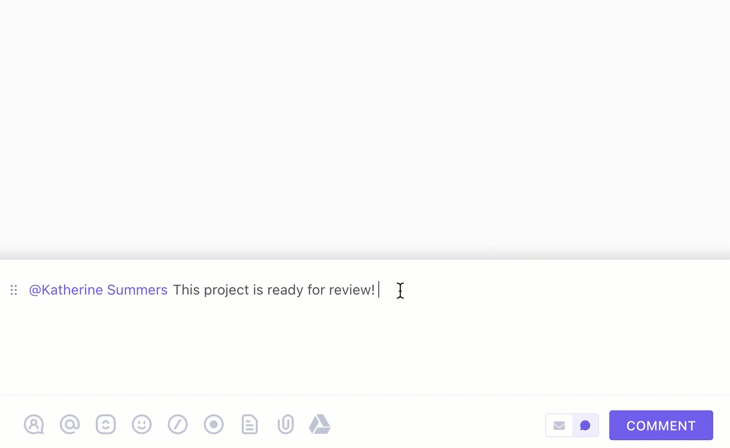
تواصل مع أعضاء الفريق باستخدام ميزة @mention على ClickUp
- لمناقشة العناصر غير المتعلقة بالمهاميوفر ClickUp عرض الدردشة. يمكن للموظفين استخدام هذه الميزة لتوضيح شكوكهم وإبداء الملاحظات أو طلبها والتواصل مع أعضاء الفريق على الفور، دون مغادرة مساحة عمل ClickUp

تحدث عن عناصر العمل غير المتعلقة بمهام محددة، واعرض جميع المرفقات المضمنة في مكان واحد باستخدام طريقة عرض الدردشة في ClickUp
- اسمح لموظفيك بالتعاون في الوقت الحقيقي باستخدامكشف التعاون في ClickUp. يمكن لأي شخص التحقق من أي شخص آخر يقوم بعرض مهمة أو تحريرها أو إضافة تعليقات جديدة في نفس الوقت. تتيح هذه الميزة للموظفين عن بُعد البقاء على نفس الصفحة فيما يتعلق بالمشاريع وأن يكونوا أكثر إنتاجية
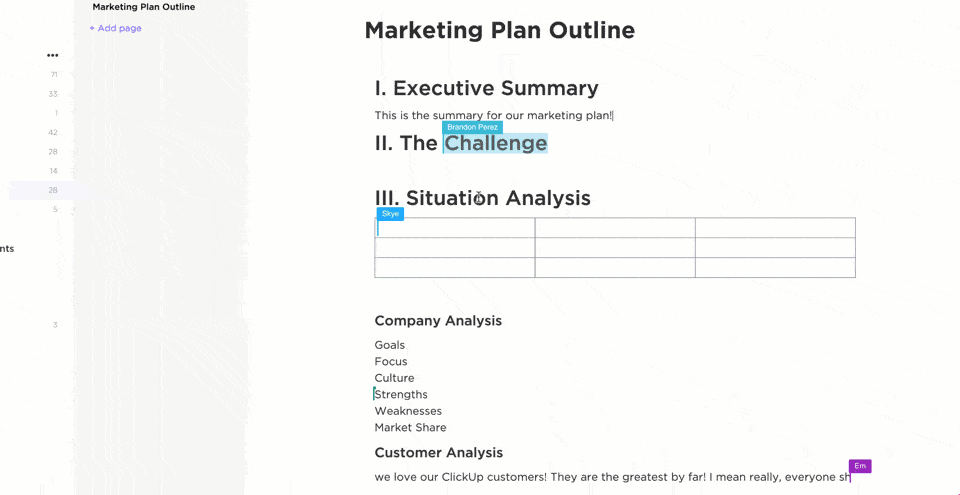
تعاون في المشاريع في وقت واحد باستخدام ميزة "اكتشاف التعاون" في ClickUp
- تبسيط التواصل بين الفرق الداخلية وأصحاب المصلحة الخارجيين مع العديد منقوالب خطة التواصل في ClickUp
أبقِ أعضاء الفريق على اطلاع دائم بالمهام والمسؤوليات والمواعيد النهائية والمزيد باستخدام قالب تقرير مصفوفة الاتصالات ClickUp
- اجعل عملية الارتقاء بالمهارات أقل إرباكًا باستخدامClickUp إدارة المشاريع أداة. قم بتقسيم برامج تدريب الموظفين أو المواد التعليمية إلى وحدات صغيرة باستخدام المهام، وأضف جداول زمنية لكل وحدة، وساعد موظفيك على متابعة تقدمهم

قسّم المشاريع الكبيرة إلى عناصر صغيرة قابلة للتنفيذ لسهولة التنفيذ باستخدام مهام ClickUp Tasks
- اربط المهام والمستندات وعمليات التكامل والموارد الأخرى المتعلقة بالتدريب ضمن مساحة عمل واحدة باستخدام العلاقات على ClickUp بحيث يمكنك أنت وفريقك الوصول إليها وقتما تشاء

أنشئ روابط بين المهام ونظم المستندات وعمليات التكامل والموارد ذات الصلة في نفس المساحة باستخدام ClickUp Relationships
- سواء كان برنامجًا تدريبيًا أو مشروع عميل، يمكن للفرق الحصول على نظرة عامة على جميع مهامهم باستخدام لوحة معلومات ClickUp الرشيقة. ويمكنهم تصور التقدم المحرز باستخدام المخططات الدائرية والرسوم البيانية الشريطية والرسوم البيانية الخطية وإدارة أعباء العمل بفعالية

تصور التقدم المحرز باستخدام لوحة معلومات ClickUp الرشيقة
- قم بتخطيط المشاريع وإدارتها بوضوح، وتوصيل المسؤوليات، والحصول على تحديثات التقدم، والحفاظ على تركيز الفرق البعيدة على الأهداف المشتركة مع لوحة المعلومات القابلة للتخصيص بالكاملقالب خطة إدارة فريق ClickUp لإدارة الفريق
يوحّد قالب إدارة فريق ClickUp للفرق متعددة الوظائف بهدف جماعي
2. مواءمة الموظفين مع قيم شركتك
إن ترسيخ ثقافة متماسكة في مكان العمل هو هدف أي مؤسسة. ابدأ بدمج قيم الشركة في عملياتك اليومية. وضح كيف يمكن لكل عضو من أعضاء الفريق المساهمة في هذه القيم وتأسيس شعور جماعي بالهدف والوحدة.
هذه المواءمة أمر بالغ الأهمية بشكل خاص لأعضاء الفريق عن بُعد، الذين قد يجدون صعوبة في فهم رؤية الشركة ورسالتها وقيمها.
3. تشجيع الاستراحات المنتظمة
عزز الصحة العقلية والبدنية للموظفين من خلال تشجيعهم على أخذ استراحات صغيرة خلال يوم العمل. تمنع فترات التوقف القصيرة الإرهاق وتحسن التركيز وتعزز الإنتاجية.
خلال فترات الاستراحة هذه، يمكن للموظفين تناول وجبة خفيفة، أو التنزه، أو التحديق خارج النافذة، أو تمديد أرجلهم، أو مداعبة صديق ذي فرو، أو القيام بأي شيء للاسترخاء.
4. تعزيز التوازن بين العمل والحياة
اجعل موظفيك يضعون في اعتبارهم التوازن بين العمل والحياة الشخصية وعزز الإدارة الفعالة للوقت. تبسيط إجراءات العمل المعقدة باستخدام قوالب قابلة للتخصيص مثل قوالب إدارة المشاريع أو قوالب الموارد البشرية ، واجعل فريقك يدير وقته بشكل أفضل، ويقلل من عبء العمل ويحافظ على نظرة إيجابية طوال الوقت.
اذهب إلى أبعد من ذلك وشجعهم على عدم أخذ العمل إلى المنزل، والاستفادة من إجازاتهم المدفوعة الأجر، وعدم الانعزال عن العمل خلال العطلات.
عيّن مهام المشروع وقم بإدارتها وتحديد أولوياتها وتتبع التقدم المحرز فيها باستخدام قالب إدارة المشاريع من ClickUp ووفر وقتًا ثمينًا
5. تنظيم أنشطة بناء الفريق
رتب أنشطة بناء الفريق لفريقك لتشجيع التعاون والتواصل. يؤدي الانخراط في تجارب مشتركة، مثل تحديات حل المشكلات أو المغامرات في الهواء الطلق، إلى تطوير الوحدة والصداقة الحميمة بين الزملاء.
يمكن أن تؤثر هذه التجارب بشكل مباشر وإيجابي على إنتاجية الموظفين وإبداعهم ورضاهم الوظيفي.
6. الاعتراف بإنجازات الموظفين وإنجازاتهم
اعترف بالإنجازات الفردية والجماعية واحتفل بها، مهما كانت كبيرة أو صغيرة. تعمل ثقافة التقدير على تحسين مشاركة الموظفين، وتدفع فريقك إلى تحقيق إنجازات أكبر، وتبقيهم متحمسين، وتعزز إحساسهم بالاتجاه.
كما أنها تلهم أعضاء الفريق الآخرين لتقديم أفضل ما لديهم من إنجازات وتحقيق أهداف أعلى.
7. تقديم الحوافز والمكافآت للموظفين
من منا لا يحب أن يكافأ على العمل الجيد؟ صمم نظام مكافآت شفاف لتقدير الأداء المتميز. يمكن القيام بذلك من خلال تقديم المكافآت أو بطاقات الهدايا أو قسائم السفر أو غيرها من المزايا الملموسة.
الحوافز تثبت صحة العمل الشاق الذي يقوم به الموظف. تخلق هذه المكافآت حلقة تعزيز إيجابية، مما يدفع الجميع إلى السعي للتميز والحفاظ على الروح المعنوية العالية.
8. إجراء عمليات مراجعة فردية منتظمة
حدد مواعيد دورية لعقد اجتماعات دورية فردية مع أعضاء فريقك لفهم عبء العمل والتحديات والأهداف المهنية والتوقعات. حاول أن تستوعب جلسة متابعة هادفة مدتها 15-30 دقيقة كل أسبوع.
على سبيل المثال، يمكن للمديرين تعيين رفاق لإكمال المهمة بشكل أسرع إذا كان أحد أعضاء الفريق يكافح للوفاء بالمواعيد النهائية. هذا النهج المخصص يجعل الموظفين يشعرون بالدعم، ويعالج مخاوفهم، ويوفر حلًا سريعًا.
تأثير بيئة مكان العمل على معنويات الموظفين
تعكس القوى العاملة المزدهرة بيئة عمل داعمة والعكس صحيح. دعونا نفهم كيف:
- تنفيذ بيئة عمل صحية* بيئة عمل صحية
تشمل بيئة العمل الإيجابية في مكان العمل القيادة الداعمة والتواصل المفتوح والتركيز على مشاركة الموظفين. حافظ على تدفق تلك الفرص للنمو المهني واجعلها تتدفق واجنِ ثمار القوى العاملة عالية المشاركة.
- تعزيز التنوع في مكان العمل
بغض النظر عن المكان الذي ينتمي إليه أي شخص، يحب الجميع الشعور بالدعم والاحترام عندما يأتون إلى العمل. هذا الإحساس بالانتماء هو عامل تغيير حقيقي لفرق العمل - فهو يحافظ على معنويات الجميع مرتفعة.
- دور ثقافة الشركة في تشكيل الروح المعنوية للموظفين
تشير الثقافة الإيجابية أيضًا إلى ارتفاع الروح المعنوية. الأمر كله يتعلق بالقيم المشتركة، والهدف، والوحدة مع طاقم العمل.
- دور القادة
تحية إلى جميع قادة الفرق ومديري الأفراد الذين يولون اهتمامًا إضافيًا باحتياجات موظفيهم!
أنت تخلق ثقافة ذات روح معنوية عالية عندما تبقي جميع خطوط الاتصال مفتوحة، وتعزز الشفافية في التغذية الراجعة، وتوائم بين أهداف الشركة والتطلعات الفردية.
ومع ذلك، فإن التعامل مع العلاقة بين الروح المعنوية للموظفين وبيئة العمل قد يكون صعباً في بعض الأحيان في الشركات المختلطة أو في المكاتب.
أهمية معنويات الموظفين في العمل عن بُعد
تلعب معنويات الموظفين دوراً حاسماً في الحفاظ على مشاركة الموظفين عن بُعد وإنتاجيتهم . كل ما عليك فعله هو وضع هذه الجوانب في الاعتبار:
- معدل دوران الموظفين: تزداد احتمالية عدم قفز موظفيك من السفينة عندما يشعرون بالتواصل والدعم والمشاركة. يمكنك عندئذٍ أن تودع معدلات الدوران المرتفعة وتركز على بناء فريقك عالي الأداء
- التغيب عن العمل: تصبح إدارة العزلة في مكان العمل والتغيب عن العمل سهلة أيضًا في الإعدادات عن بُعد عندما تحافظ على تفاعل فريقك وإطلاعه على المستجدات. يمكن أن تساعدك الجلسات الافتراضية المتكررة في بناء تلك الصداقة الحميمة التي تشتد الحاجة إليها مع فريقك
- التحفيز والإنتاجية: يمكن للشركات تقديم الدعم من خلال الاستثمار فيبرنامج مكان العمل الرقميوالتدريب والموارد التي تمكّن القوى العاملة عن بُعد. كن مطمئناً، سيشعر فريقك بأنه مجهز بالكامل للتعامل مع مهامه بكفاءة. كما أن التغذية الراجعة البناءة والاعتراف بالجهود المبذولة في الوقت المناسب سيقطع شوطًا طويلاً في تعزيز الحافز والإنتاجية
استخدم المجموعة الصحيحة من الأدوات والاستراتيجيات الصحيحة لجعل القوى العاملة عن بُعد تشعر بأن فريق العمل عن بُعد لديك فريق عمل مترابط، حتى لو كانوا في أجزاء مختلفة من العالم.
فوائد وتحديات الحفاظ على الروح المعنوية العالية للموظفين
إن الشعور بالإيجابية والحماس سيميز مكان عملك عن مكان العمل العادي. عندما تتحسن معنويات الموظفين، تتحسن كذلك ثقافة العمل في شركتك لأنها,
- تحفز الموظفين على تقديم أفضل ما لديهم
- تساعدهم على الحفاظ على تركيزهم وإنتاجيتهم
- يزيد من الرضا الوظيفي ويقلل من معدلات دوران الموظفين
- يعزز التواصل والتعاون
- يزيد من حضور الموظفين ومشاركتهم
- يلهم فرق العمل على الابتكار والالتزام بأدوارهم
- يقلل من مستويات التوتر؛ ويبعد الإرهاق الذهني
- يبني سمعة إيجابية في مكان العمل
- يساعد على تقديم تجربة عملاء محسّنة
لكن العمل ليس دائمًا ما يكون مشرقًا وقوس قزح. يمكن أن يكون الحفاظ على معنويات عالية باستمرار تحدياً حقيقياً عندما تصبح الأمور مرهقة - مثل المواعيد النهائية الضيقة، أو تخفيضات الميزانية، أو التغييرات الكبيرة في الشركة.
مثل هذه المواقف تتطلب منك أن تكون أكثر استباقية. ستساعدك المناقشات المفتوحة مع أعضاء فريقك ومد يد الدعم لهم وتقديم أدوات إدارة الضغوطات على الإبحار في هذه المواقف!
كل شيء يبدأ بأداة مساحة العمل المناسبة
الموظفون هم القوة الدافعة للمؤسسة. إذا كنت تدرك أهمية الروح المعنوية العالية للفريق وكنت على استعداد لبذل المزيد من الجهد، فستحصل على مكان عمل مزدهر في أي وقت من الأوقات!
ابدأ مبادرتك بـ أداة إدارة العمل مثل ClickUp. فهي تبسّط التواصل والتعاون، وتتيح لك تصور كيفية تأثير الجهود الفردية في مؤسسة كبيرة، وتبسط عمليات الأعمال لتحسين الكفاءة.
اجعل فريقك يشعر بأنه يعمل لأكثر من مجرد راتب. ابدأ مع ClickUp اليوم!
الأسئلة الشائعة الشائعة
1. كيف يمكنك تحسين الروح المعنوية في الفريق؟
عندما تشجع التواصل المفتوح، وتحتفل بانتصارات الموظفين، وتقدر التعاون، فإن تحسين معنويات فريقك لا يستغرق وقتًا طويلاً.
2. كيف تحفز فريقاً معنوياته منخفضة؟
إذا كان فريقك يشعر بانخفاض معنوياته، قدم لهم دعمك. اعترف بجهودهم وأشركهم في اتخاذ القرارات لتوفير حافز إضافي لهم.
3. كيف تعيد بناء معنويات الفريق؟
يمكنك إعادة بناء الروح المعنوية لفريقك من خلال وضع توقعات واضحة، وتوصيل الأهداف، وتقديم توجيهاتك.


